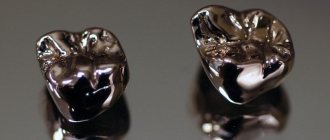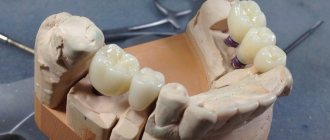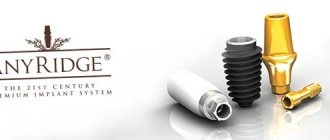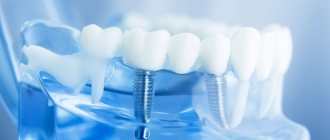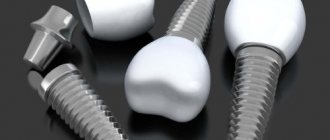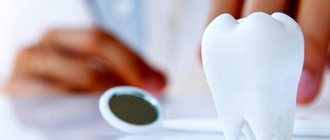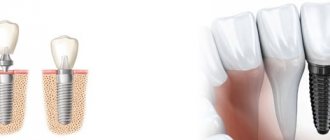Implantation of upper chewing teeth
In the upper jaw, the maxillary sinuses are located close to the roots of the molars and premolars, therefore, when implanting the upper chewing teeth located in this section, osteoplastic surgery is required in 80 - 90% of cases. The procedure of lifting the lower part of the sinus (maxillary sinus) and filling the space with biocompatible bone material is called a sinus lift. On the one hand, this is a completely simple procedure, but on the other hand, it requires certain knowledge and skill from the doctor. Therefore, it should only be done by trusted specialists.
Make an appointment
right now!
Bely Dmitry Valentinovich
Surgeon, Therapist, Implantologist
Implantation of lower chewing teeth
From a process point of view, implantation of chewing teeth in the lower jaw is the same as in the upper jaw. The fundamental difference is only in the timing of implant healing. When implanting lower chewing teeth, osseointegration occurs much faster than with implants in the upper jaw. It takes only about three months for complete engraftment. By the way, if osteoplastic surgery for implanting upper chewing teeth is called “sinus lifting,” then in the case of lower teeth it falls under the general concept of bone grafting.
What kind of implants are placed on chewing teeth?
If you think that dentists use the same implants to replace all types of teeth, you are wrong. Each clinical case uses its own treatment protocol and implant system, which should provide optimal results in terms of functionality and aesthetics. So, what kind of implants are placed on chewing teeth? To restore teeth in the lateral part of the jaw, implants that are too thin and short are not used. Depending on the anatomical features of the jaw structure and the width of the interdental spaces, the doctor selects their optimal size. As for the technique, classic two-stage implantation is usually used to restore chewing teeth (when an artificial root, after installation, is sutured into the gum and undergoes the process of osseointegration for 3 to 6 months). This is necessary for the implant to fuse with the bone tissue as efficiently as possible and subsequently withstand the chewing load.
During the engraftment stage, the patient is usually fitted with a temporary prosthesis, after which a permanent structure is installed. Almost all modern manufacturers have a line of implants for restoring molars and premolars. Both top-end and budget systems perform essentially the same function, but more expensive brands provide greater opportunities for prosthetics, and also allow you to obtain equally high functional and aesthetic results. In any case, your attending physician should tell you which implant is best placed on the chewing teeth in a particular case.
Important!
The human jaw creates a load of 400 kilograms, so the artificial root must have a large margin of strength.
Digital diagnostics - to eliminate risks
Computer tomograph Sirona Galileos (Germany) provides thorough diagnosis and planning
- Assessment of bone structure and size to select an implantation protocol
- Determining the location of the mandibular nerve to avoid damage
- Preliminary 3D modeling of the operation, creation of navigation templates
Bridge or implant on a chewing tooth: which design is better?
If several chewing teeth are missing in a row, a dilemma often arises: to place a bridge or an implant on the chewing tooth. Of course, the best option would be to place an implant on the chewing tooth, and then install an abutment and crown, but this is not always possible to do due to the high cost of the procedure and the lack of the required volume of bone tissue. In such cases, the patient is asked to install a bridge supported by his own teeth. The main disadvantages of such prosthetics are depulpation and grinding of supporting teeth, as well as increased load on them, which over time leads to their destruction.
PiezoSurgery® - gentle tooth extraction and bone grafting
Ultrasonic scalpel NSK VarioSurg 3 for gentle pre-implantation preparation
- Affects only bone tissue without damaging nerves and blood vessels
- Gently works with bone in osteoplasty protocols
- Atraumatic tooth extraction without chips or fractures of surrounding tissues
Implants for chewing teeth - patient reviews
Patient reviews of the procedure for implanting chewing teeth are almost always positive, since today this technique allows you to be almost 100% confident in a good final result. Negative impressions are usually associated with the unprofessionalism of the doctor and an incorrectly performed implantation procedure. As for reviews of implants for chewing teeth from specific manufacturers, the leading brands include Nobel Biocare, Straumann and Astra Tech.
In any case, classical dental implantation can be performed only in the absence of serious contraindications, which include diseases of the immune system and periodontal disease, cancer and diabetes. If such restrictions exist, tooth restoration is carried out in other ways.
Which technology for implanting lower teeth should I choose?
Choosing an implantation protocol for restoring lower jaw teeth is a task that needs to be decided together with a doctor. Only a specialist will be able to give recommendations on the implantation technology that will be optimal in your case. And he will do this based not only on an examination of your oral cavity, but also based on detailed diagnostic data. It is extremely important to remember the following: dental implantation is a serious type of surgical intervention, which must be carried out without the slightest errors and inaccuracies, which are fraught with serious and even dangerous complications. Therefore, if you are thinking about dental implantation, start by choosing a good clinic and a competent and experienced implantologist!
Our dental clinic in Moscow “Firadent” has created all the conditions for comfortable dental treatment and implantation. The clinic is equipped with modern diagnostic equipment; we use navigational implantation technology, which allows us to create surgical templates and implant implants precisely in the selected area and at the right angle. We work with the world's leading manufacturers of implantation systems, and if you are afraid of pain or simply have a strong fear of dental treatment, we are ready to offer you all procedures under sedation - medicated sleep, which is an easy and safe alternative to general anesthesia.
Getting a consultation from our clinic’s implantologists is easy and simple: make an appointment with a specialist using the contact phone numbers listed on the website.
Implantation of chewing teeth - price in Moscow
The price for implantation of chewing teeth consists of the cost of the implant, dental crown and the doctor’s work. If you are diagnosed with a lack of bone tissue volume, the cost of the procedure will increase slightly. Estimated prices for implantation of chewing teeth in Moscow start from 30 thousand rubles per tooth and reach 60 thousand and above. In order to save significantly, you should pay attention to inexpensive implantation systems: MIS, Alpha Bio, Xive, Impro, Osstem and others.
Publisher: Expert magazine about dentistry Startsmile.ru
Branded rehabilitation - for quick recovery
A unique complex of accelerated rehabilitation on the day of surgery
- Lymphatic drainage. Lymphatic drainage preparations tighten the facial contour, reduce swelling, relieve inflammation
- PRP plasma lifting. Enriched blood plasma improves tissue regeneration, lightens hematomas, reduces swelling
- Microcurrent therapy. Relieves muscle spasms, reduces pain, removes swelling
Our Center uses exclusively Nobel Biocare implants. They fully restore the functionality of the dentition, cope with serious chewing loads, and eliminate bone tissue atrophy. Serve as a reliable support for artificial crowns and dentures.
Crowns and dentures are manufactured in Zirkonzahn Schule's own automated digital production or at the PROCERA plant (in the USA).
Since 2004, our clinic has been the Nobel Biocare Center of Clinical Excellence in Eastern Europe. Together with the manufacturer, we provide an indefinite guarantee for implantation in the LifeTime Warranty format.
What's included in the price
Our Center has developed a case-based “turnkey” payment system. Implantation of lower teeth combines cases for installing an implant, crown or prosthesis. If necessary, cases of tooth extraction, bone and soft tissue plastic surgery are added.
The implantation case includes:
- local anesthesia
- implant and its installation
- auxiliary operations for basic bone tissue augmentation, including regeneration stimulators
- applying and removing sutures
- postoperative examinations and CT scans during the rehabilitation period
- antibiotics, painkillers (delivered at home)
The crown installation case includes:
- crown and its installation
- taking impressions
- abutment
The case for tooth extraction with pre-implantation preparation using an ultrasound protocol includes:
- anesthesia
- doctor's work
- Consumables
- socket bone restoration
For bone grafting and sinus lifting, osteoplastic materials are paid separately, because the required amount for different clinical situations is individual. Materials are written off at purchase price without markups.
Contraindications
Relative
the procedure can be carried out with extreme caution
- Unsatisfactory condition of the oral cavity;
- pregnancy;
- period of exacerbation of chronic diseases.
Absolute
the procedure is strictly prohibited
- Blood diseases;
- severe diabetes mellitus;
- immune diseases;
- severe form of tuberculosis;
- osteoporosis;
- endocrine disorders;
- oncological pathologies;
- intolerance to anesthesia drugs;
- serious diseases of the central nervous system.
Alternative options
If there is a lack of teeth in the chewing region, an alternative treatment option may be the installation of removable orthopedic structures. However, it is not always possible to fix a bridge-type prosthetic device. Sometimes the patient only has supporting units on one side of the defect, which explains the need to use a removable prosthetic system that is fixed to these teeth and gums.
Removable prosthesis. This is a fairly low-cost system that is accessible to the vast majority of patients. However, along with the effectiveness of this design, there are some negative aspects associated with its operation:
- Uncomfortable to wear. Due to the presence of a massive acrylic base, the prosthetic device can cause irritation of the gum tissue;
- Insufficiently strong fixation. Many patients resort to the use of additional gels, ointments and adhesives;
- Light load. Due to the lack of necessary pressure on the bone, it undergoes further resorption. Over time, this deteriorates the strength of the prosthetic device and leads to the need for its relocation.
Taking into account the above disadvantages, we can judge the advisability of installing dental implants instead of removable prosthetic devices using one’s own teeth as supports.
Author:
Advantages and disadvantages
Advantages
- Reliability;
- natural appearance of the dentition;
- long service life;
- implantation stops the process of bone tissue resorption.
Flaws
- It is often necessary to build up the jawbone when using the classic protocol. With one-stage - only in cases of extreme bone deficiency;
- traumatic;
- likelihood of complications, discomfort during rehabilitation;
- treatment period (up to a year with classical implantation);
- contraindications.
Features of operations on the lower jaw
When restoring the lower dentition, the main requirements are for functionality. The stability of the implants, resistance to heavy chewing loads, as well as its correct distribution to all areas of the jawbone come to the fore. Aesthetics comes in second place, since the bottom row is practically invisible when smiling, communicating or eating.
Achieving your goals is easier than with maxillary implantation. The lower bone has a denser structure and is less subject to atrophy due to constant high chewing loads. The primary stability of installed implants is higher, and the healing time is shorter.
The main task of the doctor is the correct selection of implantation techniques. It should ensure even distribution of pressure during chewing. The stability and functionality of the prosthesis, as well as the rate of its wear, depend on the number and position of implants.
Straumann: restores health and self-confidence
The company from Switzerland produces high-quality implants, tested in its own scientific laboratory. The German Implantology Center selects proven Straumann implant models that have proven their clinical and practical effectiveness:
- Universal pins with a sealed abutment-implant connection.
- SLA coated options. The composition accelerates the installation of an artificial root and promotes rapid tissue restoration.
Preferring a well-known brand, you will receive dental implantation in the Center’s clinics relatively inexpensively and of high quality.
Manufacturer and clinic warranty period
No implantologist can give an absolute guarantee of implant survival; there is always a risk of rejection. The reasons are different, but sometimes rejection occurs due to incorrect actions by the doctor or the installation of a low-quality implant. Therefore, choosing a dentist from a specialist should be taken seriously.
The manufacturer provides a guarantee for implants. Re-implantation at the expense of the manufacturer of the structure is performed if rejection is caused by poor quality of the product. It can be 10-20 years, and some companies even provide lifetime. The clinic's guarantee covers the quality of the operation and lasts 1-2 years. Free re-implantation is performed if it is proven that the rejection occurred due to incorrect actions of the doctor.
- Complete restoration of the dentition in just 4 days!
more detailsRoott Pterygoid Implants Sinus lift is no longer needed!
more details
Once and for life! Express implantation in 4 days with a permanent ReSmile prosthesis
more details
All-on-4, All-on-6, ReSmile, Zygomatic implantation We use all modern methods of dentition restoration
more details
German quality Ankylos
German Ankylosis implants, used in the clinics of the German Implantology Center, are distinguished by a special thread and a special type of porous surface, which is patented. The thread of the implants is arcuate. Ankylosis implants have an ideal fit of the gingival part, which makes the product in demand for the restoration of the frontal row. Artificial roots of this German brand take root approximately 2 times faster than inexpensive implants used in other clinics such as Impro and Biohorizons. Clinical and practical observations show that Ankylos implant systems are stable in bone even decades after their installation.
Other Alternatives
Lost molars can be replaced with removable dentures. The device is selected taking into account the size and location of the defect. For prosthetics, acrylic plate, nylon, clasp structures, devices with hooks or locking type of fastening are used. The advantage of the method is the price. Minuses:
- unreliable fixation of the prosthesis;
- false jaws are not able to replace their own during the chewing process;
- pain occurs while eating;
- possible damage to mucous membranes;
- devices for the upper row often cause nausea;
- the tissues under the prosthesis continue to sag;
- Over time, the device will require relocation.
What problems are encountered with maxillary implantation?
Replacement of lost premolars and molars in the upper jaw is always fraught with problems. Its lateral sections border the bottom of the maxillary sinus, and any loss of bone tissue in this place is fraught with problems with implantation. Yes, actually, not only with her. Any manipulation in this area can lead to complications - perforation of the maxillary sinus and the development of odontogenic sinusitis.
In some cases, the bone tissue is naturally thin, and the roots of the tooth may initially be located in the maxillary sinus. It is inconvenient to fill such a tooth, and after removal there remains a gaping hole connecting the oral cavity and the sinus. Naturally, in this case, immediate implantation is impossible, and the patient is indicated for bone grafting.
This operation in case of replacing long-missing teeth (over six months) is needed in 80-90 percent of cases. It complicates implantation and delays the achievement of results. Previously, the procedure was mandatory and added another 6-8 months to the total treatment period. Today, our clinic uses modern protocols that allow sinus lifting and implantation to be performed on the same day. You can find out more during your consultation.
Complications and side effects
Implantation is a surgical procedure and carries a risk of complications. Side effects can occur within a few days or weeks, or after 2-3 years.
The following factors can provoke the development of complications:
- Chronic diseases.
- Insufficient examination, inaccurate history taking and incorrect diagnosis, which led to the failure to identify existing contraindications.
- Mistakes made by the implantologist during surgery.
- Neglect of the patient's advice on care.
Immediately after implantation or within a short time, the following complications may begin:
- Painful sensations . Occurs after the anesthesia wears off. A normal reaction is the persistence of painful sensations for no more than three days, during which analgesics can be taken. Prolonged pain may indicate inflammation or nerve damage.
- Swelling. A normal reaction to a violation of the integrity of oral tissues. It appears a few hours after surgery and disappears after 5-7 days. If it persists for more than a week, it may be a symptom of soft tissue inflammation. To reduce swelling, it is recommended to apply cold to the injury site.
- Some bleeding in the first few days is normal. May be caused by taking medications that reduce blood clotting. Severe bleeding or minor bleeding that does not stop for 10 days is a sign of damage to the blood vessels, which is dangerous due to the formation of a hematoma, suture dehiscence, or suppuration.
- Temperature increase . An increase in temperature to 37-38°, observed within three days, is considered normal. Prolonged fever is a sign of an inflammatory process.
- Seams coming apart . Happens due to:
- mechanical damage;
- improper suturing;
- inflammation.
A few months after surgery, the following may occur:
- Peri-implantitis is an inflammation of the jaw bone around a dental structure. Peri-implantitis develops for the following reasons:
- trauma to the wall of the nasal cavity;
- development of bleeding over the plug, causing hematoma and suppuration;
- making a mistake when closing a postoperative wound;
- incorrect technique for forming a bed for the implant;
- inflammation that has developed in a neighboring tooth;
- allowing for inaccuracies in the manufacture of the prosthesis;
- failure to comply with hygiene rules by the patient.
- peri-implantitis;
- insufficient bone volume;
- excessive bone damage during implantation;
- exacerbation of chronic diseases;
- allergy to the rod material;
- smoking;
- temperature damage to jaw tissue;
- osteoporosis of the jaw.
Progress and quality of Bredent implants
These are relatively new dental implants. Our clinics use a range of zirconium dioxide. The Bredent line of implants is suitable for allergy sufferers and people experiencing difficulties with tissue regeneration. The risk of rejection of such implants is almost zero.
The artificial zirconium root has a snow-white hue, is aesthetically pleasing and is suitable for installing a ceramic crown without additional manipulation. Demanded for restoring front teeth. There are models for recreating lost units in narrow spaces between natural teeth, and rulers for weakened bone mass.
